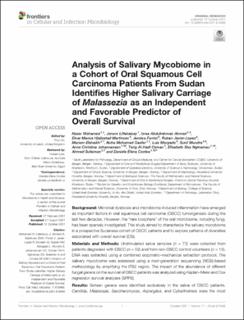| dc.contributor.author | Mohamed, Nazar | |
| dc.contributor.author | Litlekalsøy, Jorunn | |
| dc.contributor.author | Ahmed, Israa Abdul Rhman | |
| dc.contributor.author | Martinsen, Einar Marius Hjellestad | |
| dc.contributor.author | Furriol, Jessica | |
| dc.contributor.author | Javier-Lopez, Ruben | |
| dc.contributor.author | Elsheikh, Mariam | |
| dc.contributor.author | Mohamed, Nuha Mohamed Gaafar | |
| dc.contributor.author | Morgado, Luis | |
| dc.contributor.author | Mundra, Sunil | |
| dc.contributor.author | Johannessen, Anne Christine | |
| dc.contributor.author | Osman, Tarig Al-Hadi | |
| dc.contributor.author | Nginamau, Elisabeth Sivy | |
| dc.contributor.author | Suleiman, Ahmed | |
| dc.contributor.author | Costea, Daniela Elena | |
| dc.date.accessioned | 2021-11-29T09:07:04Z | |
| dc.date.available | 2021-11-29T09:07:04Z | |
| dc.date.created | 2021-11-05T14:07:51Z | |
| dc.date.issued | 2021-10-12 | |
| dc.identifier.issn | 2235-2988 | |
| dc.identifier.uri | https://hdl.handle.net/11250/2831818 | |
| dc.description.abstract | Background: Microbial dysbiosis and microbiome-induced inflammation have emerged as important factors in oral squamous cell carcinoma (OSCC) tumorigenesis during the last two decades. However, the “rare biosphere” of the oral microbiome, including fungi, has been sparsely investigated. This study aimed to characterize the salivary mycobiome in a prospective Sudanese cohort of OSCC patients and to explore patterns of diversities associated with overall survival (OS).
Materials and Methods: Unstimulated saliva samples (n = 72) were collected from patients diagnosed with OSCC (n = 59) and from non-OSCC control volunteers (n = 13). DNA was extracted using a combined enzymatic–mechanical extraction protocol. The salivary mycobiome was assessed using a next-generation sequencing (NGS)-based methodology by amplifying the ITS2 region. The impact of the abundance of different fungal genera on the survival of OSCC patients was analyzed using Kaplan–Meier and Cox regression survival analyses (SPPS).
Results: Sixteen genera were identified exclusively in the saliva of OSCC patients. Candida, Malassezia, Saccharomyces, Aspergillus, and Cyberlindnera were the most relatively abundant fungal genera in both groups and showed higher abundance in OSCC patients. Kaplan–Meier survival analysis showed higher salivary carriage of the Candida genus significantly associated with poor OS of OSCC patients (Breslow test: p = 0.043). In contrast, the higher salivary carriage of Malassezia showed a significant association with favorable OS in OSCC patients (Breslow test: p = 0.039). The Cox proportional hazards multiple regression model was applied to adjust the salivary carriage of both Candida and Malassezia according to age (p = 0.029) and identified the genus Malassezia as an independent predictor of OS (hazard ratio = 0.383, 95% CI = 0.16–0.93, p = 0.03).
Conclusion: The fungal compositional patterns in saliva from OSCC patients were different from those of individuals without OSCC. The fungal genus Malassezia was identified as a putative prognostic biomarker and therapeutic target for OSCC. | en_US |
| dc.language.iso | eng | en_US |
| dc.publisher | Frontiers | en_US |
| dc.rights | Navngivelse 4.0 Internasjonal | * |
| dc.rights.uri | http://creativecommons.org/licenses/by/4.0/deed.no | * |
| dc.title | Analysis of salivary mycobiome in a cohort of oral squamous cell carcinoma patients from Sudan identifies higher salivary carriage of malassezia as an independent and favorable predictor of overall survival | en_US |
| dc.type | Journal article | en_US |
| dc.type | Peer reviewed | en_US |
| dc.description.version | publishedVersion | en_US |
| dc.rights.holder | Copyright 2021 the authors | en_US |
| dc.source.articlenumber | 673465 | en_US |
| cristin.ispublished | true | |
| cristin.fulltext | original | |
| cristin.qualitycode | 1 | |
| dc.identifier.doi | 10.3389/fcimb.2021.673465 | |
| dc.identifier.cristin | 1951843 | |
| dc.source.journal | Frontiers in Cellular and Infection Microbiology | en_US |
| dc.source.pagenumber | 15 | en_US |
| dc.identifier.citation | Frontiers in Cellular and Infection Microbiology. 2021, 11, 673465. | en_US |
| dc.source.volume | 11 | en_US |

